《智能移动机器人》结课论文
智能移动机器人论文[1]
![智能移动机器人论文[1]](https://img.taocdn.com/s3/m/3a9377c00c22590102029d92.png)
智能移动机器人的现状与发展智能机器人之所以叫智能机器人,这是因为它有相当发达的“大脑”。
在脑中起作用的是中央计算机,这种计算机跟操作它的人有直接的联系。
最主要的是,这样的计算机可以进行按目的安排的动作。
正因为这样,我们才说这种机器人才是真正的机器人,尽管它们的外表可能有所不同。
我们从广泛意义上理解所谓的智能机器人,它给人的最深刻的印象是一个独特的进行自我控制的“活物”。
其实,这个自控“活物”的主要器官并没有像真正的人那样微妙而复杂。
智能机器人具备形形色色的内部信息传感器和外部信息传感器,如视觉、听觉、触觉、嗅觉。
除具有感受器外,它还有效应器,作为作用于周围环境的手段。
这就是筋肉,或称自整步电动机,它们使手、脚、长鼻子、触角等动起来。
我们称这种机器人为自控机器人,以便使它同前面谈到的机器人区分开来。
它是控制论产生的结果,控制论主张这样的事实:生命和非生命有目的的行为在很多方面是一致的。
正像一个智能机器人制造者所说的,机器人是一种系统的功能描述,这种系统过去只能从生命细胞生长的结果中得到,现在它们已经成了我们自己能够制造的东西了。
智能机器人能够理解人类语言,用人类语言同操作者对话,在它自身的“意识”中单独形成了一种使它得以“生存”的外界环境——实际情况的详尽模式。
它能分析出现的情况,能调整自己的动作以达到操作者所提出的全部要求,能拟定所希望的动作,并在信息不充分的情况下和环境迅速变化的条件下完成这些动作。
当然,要它和我们人类思维一模一样,这是不可能办到的。
不过,仍然有人试图建立计算机能够理解的某种“微观世界”。
比如维诺格勒在麻省理工学院人工智能实验室里制作的机器人。
这个机器试图完全学会玩积木:积木的排列、移动和几何图案结构,达到一个小孩子的程度。
这个机器人能独自行走和拿起一定的物品,能“看到”东西并分析看到的东西,能服从指令并用人类语言回答问题。
更重要的是它具有“理解”能力。
为此,有人曾经在一次人工智能学术会议上说过,不到十年,我们把电子计算机的智力提高了10倍;如维诺格勒所指出的,计算机具有明显的人工智能成分。
智能机器人毕业论文.doc

摘要智能机器人被人们称为第三代机器人,是能利用感觉和识别功能做决策行动的机器人。
本文以慧鱼创意组合模型为平台,设计出一种智能机器人——循迹边界识别小车。
小车利用微动开关检测边界,利用光电管进行循迹。
小车采用慧鱼智能接口板进行控制,用直流电动机驱动。
该智能小车的机械结构可以实现反复拆装,无限组合。
控制软件为ROBO Pro,控制机器人完成一系列复杂动作:如寻找轨迹——沿轨迹行走——遇到边界停止——回避边界——继续寻找轨迹——继续沿轨迹行走等。
本文首先对小车的总体结构进行分析,确定驱动方案和传动方案,然后按照模块化设计方法组装搭建小车结构,最后对智能小车的循迹和边界识别的控制系统进行了研究,完成了智能小车硬件设计及软件设计,成功实现了主动循迹和边界识别功能。
关键词:智能机器人慧鱼循迹边界识别------------word文档可编辑-------------Tracking and boundary identification of the smart carAbstractIntelligent robots are known as the third-generation robot, it is able to utilize to feel and identify decision-making action. In this paper, the creative combination of Fischertechnik model as a platform to design an intelligent robot - car tracking to avoid the cliff. Car use micro-switches test the cliff and use photocell cell for tracking. The cars adopt Fischertechnik Intelligent board with two DC motor drive. The intelligent car's mechanical structure can be repeated disassembly, infinite combinations. Control system can identify ROBO PRO as the core. Such as the searching for the track、walking along the tracks、stopping to face cliff、avoiding the cliff 、continuing to look for the track and continuing to walk along the track. In this paper, the first analysis the overall structure of the car to determine the driver program and drive program, establish the car in accordance with the method of modular design structure and finally research the car control system. In this paper, study the smart car tracking and avoiding the cliff, completed the Smart car hardware production and software design, and successfully implemented the function of tracking and avoiding the cliff.Keywords : Robot; Fischertechnik ; Tour Line; Boundary identification- II -目录摘要 (I)ABSTRACT ..................................................................................................................... I I 第1章绪论 (1)1.1选题背景及意义 (1)1.2国内外机器人的发展现状 (2)1.3慧鱼机器人的前景 (3)第2章智能小车的总体设计 (5)2.1智能小车实现功能 (5)2.1.1边界识别功能 (6)2.1.2循迹功能 (6)2.1.3循迹加边界识别功能 (6)2.2小车驱动方案的对比分析及选择 (6)2.3智能小车传动方案的对比分析及选择 (7)2.4小车控制系统的总体设计 (7)2.5循迹边界识别小车总体设计简图 (8)2.6本章小结 (9)第3章智能循线避障机器人结构设计 (10)3.1硬件设计 (10)3.2硬件的选择 (10)3.3智能车本体结构 (13)3.3.1机器人各部分设计 ............................................................................... - 13 -3.3.2机器人硬件安装 ................................................................................... - 14 - 3.4小结.. (15)第4章智能小车的软件设计 ............................................................................. - 16 - 4.1软件设计实现要求.. (16)4.2控制程序模块化 (16)4.3主程序 (17)4.4边界识别子程序 (17)边界返回方法的最优化 ................................................................................ - 18 - 4.5寻找轨迹子程序 (19)4.6进、后退、停止、左右转子程序 (20)4.7沿轨迹行走子程序 (20)4.8LLW IN3.0控制系统的调试 (21)4.8.1调试前的准备工作 ............................................................................... - 21 -4.8.2程序调试 ............................................................................................... - 22 -III- -4.9小结 (22)结论 ................................................................................................................... - 23 - 致谢 ............................................................................................................... - 24 - 参考文献 ............................................................................................................... - 25 -IV- -第1章绪论1.1选题背景及意义“慧鱼创意组合模型”又称“工程积木”,“智慧魔方”,简称“慧鱼”。
机器人技术结课论文

论文题目:智能机器人的未来发展趋势学院:机电学院专业:机械设计制造及其自动化姓名:学号:智能机器人的未来发展趋势摘要:通过老师对《机器人技术基础》的讲解,以及各组同学课外知识的介绍,还有自己通过网上查阅相关机器人的相关知识及论文,我掌握了机器人的基本知识和应用。
我对智能机器人技术的发展现状,以及世界各国智能机器人的发展水平和应用有了新的认识。
掌握了机器人的基本知识后,我对机器人的未来发展趋势有了自己的看法。
关键词:机器人、发展现状、应用、趋势1、引言机器人的定义是一种可编程和多功能的,用来搬运材料、零件、工具的操作机,或是为了执行不同的任务而具有可改变和可编程动作的专门系统。
智能机器人则是一个在感知- 思维- 效应方面全面模拟人的机器系统,外形不一定像人。
它是人工智能技术的综合实验场,可以全面地考察人工智能各个领域的技术,研究它们相互之间的关系。
还可以在有害环境中代替人从事危险工作、上天下海、战场作业等方面大显身手。
一部智能机器人应该具备三方面的能力:感知环境的能力、执行某种任务而对环境施加影响的能力和把感知与行动联系起来的能力。
智能机器人与工业机器人的根本区别在于,智能机器人具有感知功能与识别、判断及规划功能。
随着智能机器人的应用领域的扩大,人们期望智能机器人在更多领域为人类服务,代替人类完成更复杂的工作。
然而,智能机器人所处的环境往往是未知的、很难预测。
智能机器人所要完成的工作任务也越来越复杂。
对智能机器人行为进行人工分析、设计也变得越来越困难。
目前,国内外对智能机器人的研究也在不断深入。
通过对《机器人技术基础》的学习,以及课下讨论,各个小组的讲解及相关机器人视频的观看,分析了国内外的智能机器人的发展,讨论了智能机器人在发展中存在的问题,最后提出了对智能机器人发展的一些设想。
2、国内外在该领域的发展现状综述2.1智能机器人的发展现状智能机器人是第三代机器人,这种机器人带有多种传感器,能够将多种传感器得到的信息进行融合,能够有效的适应变化的环境,具有很强的自适应能力、学习能力和自治功能。
移动机器人期末论文
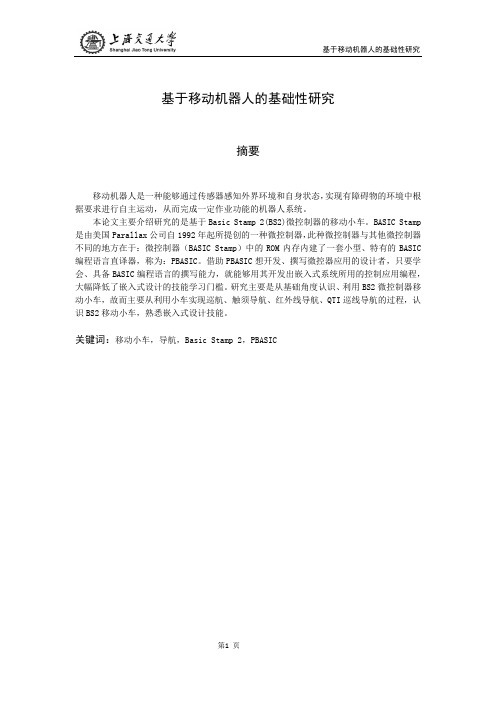
基于移动机器人的基础性研究摘要移动机器人是一种能够通过传感器感知外界环境和自身状态,实现有障碍物的环境中根据要求进行自主运动,从而完成一定作业功能的机器人系统。
本论文主要介绍研究的是基于Basic Stamp 2(BS2)微控制器的移动小车。
BASIC Stamp 是由美国Parallax公司自1992年起所提创的一种微控制器,此种微控制器与其他微控制器不同的地方在于:微控制器(BASIC Stamp)中的ROM内存内建了一套小型、特有的BASIC 编程语言直译器,称为:PBASIC。
借助PBASIC想开发、撰写微控器应用的设计者,只要学会、具备BASIC编程语言的撰写能力,就能够用其开发出嵌入式系统所用的控制应用编程,大幅降低了嵌入式设计的技能学习门槛。
研究主要是从基础角度认识、利用BS2微控制器移动小车,故而主要从利用小车实现巡航、触须导航、红外线导航、QTI巡线导航的过程,认识BS2移动小车,熟悉嵌入式设计技能。
关键词:移动小车,导航,Basic Stamp 2,PBASICMobile robot based on fundamental researchAbstractMobile robot is able to perceive the external environment through sensors and their own state, there are obstacles in the environment to achieve, in accordance with the requirements of voluntary movement, in order to complete a certain job functions of the robot system.This paper introduces the study is based on the Basic Stamp 2 (BS2) microcontroller for mobilecar. Parallax BASIC Stamp by the United States since 1992, the company created amicro-controller is proposed that such micro-controller and the other is that different parts of the microcontroller: microcontroller (BASIC Stamp) built-in ROM memory A small, unique BASIC programming language interpreter, called: PBASIC.With PBASIC who want to develop, write microcontroller applications, the designer, as long as the Society, with the BASIC programming language, writing skills, we can use it to develop embedded control applications used in the system programming, embedded design greatly reduces the learning curve of skills . From the perspective of research knowledge base, the use of mobile car BS2 microcontroller and therefore the main achieved from the use of car cruise, tentacles navigation, infrared navigation, QTI transmission line navigation of the process, understanding BS2 moving car, familiar with embedded design skills.Key words:mobile car, navigation, Basic Stamp 2, PBASIC目录第一章绪论 (5)第二章组装及测试宝贝车机器人 (6)2.1.组装宝贝车机器人【3】 (6)2.1.1.任务一:组装宝贝车机器人 (6)2.1.2.任务二:重新测试伺服电机 (6)2.1.3.任务三:开始/复位指示电路和编程 (6)2.1.4.任务四:测试带有调试终端的速度控制 (6)第三章宝贝车机器人巡航控制 (7)3.1.任务概述【4】 (7)3.1.1.基本的动作:向前,向后,左转,右转和原地旋转; (7)3.1.2.调节任务1的运动,使动作更加精确; (7)3.1.3.使机器人由突然启动或停止变为逐步加速或减速运动。
人工智能论文总结范文

摘要:随着人工智能技术的不断发展,其在智能机器人领域的应用日益广泛。
本文对近年来人工智能在智能机器人领域的研究成果进行了总结,分析了其在感知、决策、控制和协作等方面的应用,并展望了未来发展趋势。
一、引言人工智能(Artificial Intelligence,AI)是计算机科学的一个分支,旨在研究、开发用于模拟、延伸和扩展人的智能的理论、方法、技术及应用系统。
智能机器人作为人工智能的重要应用领域,近年来取得了显著的进展。
本文将总结人工智能在智能机器人领域的研究与应用。
二、人工智能在智能机器人领域的应用1. 感知(1)视觉感知:通过计算机视觉技术,智能机器人可以实现对周围环境的感知,如人脸识别、物体识别、场景理解等。
(2)听觉感知:智能机器人通过语音识别技术,可以实现对语音信息的识别和响应,如语音助手、语音翻译等。
(3)触觉感知:通过传感器技术,智能机器人可以感知接触物体的软硬、形状等特性,如力觉、触觉传感器等。
2. 决策(1)路径规划:智能机器人可以根据环境信息和任务目标,规划出最优的路径,实现自主导航。
(2)目标识别与跟踪:通过机器学习算法,智能机器人可以实现对目标的识别与跟踪,如无人机、自动驾驶等。
3. 控制(1)运动控制:通过运动规划与控制技术,智能机器人可以实现各种复杂的运动,如行走、跳跃、抓取等。
(2)力控制:通过力觉传感器和力控制算法,智能机器人可以实现对物体的精细操作,如手术机器人、工业机器人等。
4. 协作(1)人机协作:智能机器人可以与人类协同完成复杂任务,如家庭服务机器人、医疗辅助机器人等。
(2)多机器人协作:通过通信与协调算法,多智能机器人可以实现共同完成任务,如物流配送、灾害救援等。
三、未来发展趋势1. 深度学习在智能机器人领域的应用将进一步深入,如卷积神经网络(CNN)、循环神经网络(RNN)等。
2. 传感器技术的不断发展将进一步提高智能机器人的感知能力。
3. 智能机器人将向自主、高效、安全、可靠的方向发展。
智能移动机器人的现状与发展论文

智能移动机器人的现状与发展[摘要] 本文论述了智能机器人研究现状及发展动向,介绍了智能机器人研究的主要领域及相关课题,包括感觉识别技术、操作移动技术、控制技术等。
对智能机器人基础技术的研究现状进行了比较详尽的论述,最后又对智能机器人整体发展研究动向及预测。
[关键词] 智能机器人研究现状发展动向[引言] 在工业机器人问世30多年后的今天,机器人已被人们看作是一种生产工具。
在制造、装配及服务行业,机器人的应用取得了明显的进步。
由于传感器、控制、驱动及材料等领域的技术进步,通过智能机器人系统,首次在制造领域以外的服务行业,同时也开辟了机器人应用的新领域。
智能机器人是具有思维、感知和行动功智能机器人是具有思维、感知和行动功学、人工智能,微电子学,光学,传感技术、材料科学仿生学等学科的综合成果。
智能机器人可获取、处理和识别多种信息,建立并实时修正环境模型,自主地完成较为复杂的操作任务,因此,比一般的工业机器人具有更大的灵活性、机动性和更广泛的应用领域。
2O世纪电子计算机的发明,使人类的脑力劳动自动化成为可能,60年代智能机器人的出现开辟了智能生产自动化的新纪元。
机器和生产系统的智能化,用机器人代替人完成各种任务,这是人类智慧发展和机器进化的飞跃。
智能机器人作为新一代的生产工具,在制造领域中应用,能排腺人为的不可控因素,实现高节奏、高效和高质量生产,并是未来智能生产系统(如CIMS)的重要组成部分。
在非制造领域,如核工业、水下、空间,建筑、采掘,教灾排险和作战等方面,可代替人完成人所不适或力所不及的各种工作,在原予能、水下和外层空间可开辟新的产业。
目前,我国和许多国家都把智能机器人列为迎接未来挑战的高技术课题,并制订发展规划,拨出巨款给予支持。
因此,预计90年代,智能机器人技术将会有突破性的进展。
机器人的应用越来越广泛,几乎渗透到所有领域。
智能移动机器人是机器人学中的一个重要分支。
早在60年代,就已经开始了关于智能移动机器人的研究。
基于行为的人工智能微型移动机器人

基于行为的人工智能微型移动机器人班级:机研107姓名:李辉云学号:201030124020基于行为的人工智能微型移动机器人摘要实现机电一体化,移动机器人,基于行为的人工智能的概念的智能移动机器人已经研制成功。
对于此移动机器人采用了一种简单的综合了机械,电气,计算机方面的系统的原理,为了改善机器人的整体系统性能优势。
这个机器人的主要功能,名为SCAVENGER,就是在一个受控环境下能自由导航,搜索带有已知特征(彩色高尔夫球)的目标对象,并躲避其他作为障碍物的物体。
一个红外传感器,色彩探测器和保险杠的组合装置,用来使导航和识别物体变得简便。
这个机器人的大脑由一个用C语言编程的板载微控制器MC57HC00组成。
该控制软件实现了基于行为的人工智能,其中机器人的总体智力是由几个简单的,类似看起来像昆虫的原始的行为的层次组成。
在这项工作中,机器人的子系统设计,其中机电一体化的实现是最有效,包含更多的在物体识别和收集系统的特殊兴趣的细节。
1998年Elsevier科学有限公司。
版权所有。
关键词:机器人,智能目录1.简介 (4)2.设计要求和目的 (5)3. 系统整体结构 (5)4. 运动系统 (7)5. 导航系统 (8)5.1. 检测范围 (9)5.2. 障碍探测 (11)6. 物体识别系统 (11)6.1. 智能钩 (14)6.2. 颜色检测 (15)7. 物体收集系统 (16)8. 计算硬件和软件 (18)9. 结果与讨论 (19)10. 结论 (22)参考文献 (23)1.简介由于移动机器人时代的开始,移动机器人开始发出一些与运动,导航和人工智能相关的特殊挑战【1-5】。
这些机器人的流动性依靠于自己的在环境中在两个位置之间的自主导航中的能力。
为了有效地导航,移动机器人必须首先具备一个灵活的移动性和可操作性的运动系统来运动,在地形和地表条件差异很大的情况下【1,6】。
具有一个合适的运动系统,移动机器人的导航引入了两个相互关联的有关于传感器技术和导航策略的挑战。
机器人科技论文

机器人科技论文篇一浅谈智能移动机器人摘要:随着科技的进步,智能机器人性能不断地完善,移动机器人的应用范围也越来越广,广泛应用于军事、排险、农业、救援、海洋开发等。
介绍了常见智能移动机器人的基本系统组成及其相关的一些技术,提出一种能够应用于智能移动机器人的越障机构,并简单阐述了其工作原理。
在对智能机器人有一定了解的基础上,论述了智能移动机器人的研究现状及其发展动向。
关键词:智能移动机器人越障避障伸展收缩1引言上世纪60年代智能机器人的出现开辟了智能生产自动化的新时代。
在工业机器人问世50多年后的今天,机器人已被人们看作是不可缺少的一种生产工具。
由于传感器、控制、驱动及材料等领域的技术进步开辟了机器人应用的新领域。
智能移动机器人是机器人学中的一个重要分支。
2智能移动机器人的基本系统组成及其相关技术智能移动机器人是一个集环境感知、动态决策与规划、行为控制与执行等多种功能于一体的综合机电系统。
它是传感器技术,控制技术,移动技术,信息处理、人工智能、电子工程、计算机工程等多学科的重要研究成果,从某种意义上讲是机器发展进化过程中的产物,是目前科学技术发展最活跃的领域之一。
3一种越障机器人我们设计的移动机器人(图1)有很好的机动性能,前导轮、前轮和后轮可以实现独立升降运动。
前导轮(如图1)由通过曲柄圆盘的转动角度控制摇杆的摆动角度,带动相关的平面连杆机构运动,从而实现前导向轮的伸展和收缩实现攀越。
机器人两侧的侧边驱动机构为平面连杆-滑块越障机构,前后轮(如图1)分别通过导杆在槽中的移动,带动平面连杆机构的运动,实现前后轮的伸展和收缩,实现越障功能。
本机器人通过尺寸的设计可以实现较大的越障高度,通过合理的控制轮摆动的角度还能实现多种类型障碍物的攀越。
4智能移动机器人的应用概况随着科技的进步,机器人的功能不断完善,智能移动机器人的应用范围也大大拓宽,不仅在工业、农业、医疗、服务等行业中得到广泛的应用,而且在排险、海洋开发和宇宙探测领域等有害与危险场合(如辐射、灾区、有毒等)得到很好的应用。
机器人技术论文六篇

机器人技术论文六篇机器人技术论文范文1机器人技术教育是指围绕机器人而开展的教与学活动,幼儿到成人都可以是教育对象,它以多视角、多样化的教学模式,达到寓教于乐的教育目的。
机器人技术教育的内容,并不受限于传统的教学模式。
以机器人作为教学活动的载体,不仅可以使教学具有科技含量,提升同学的学习爱好,还能培育同学的创新精神、综合实践力量和协作力量。
当然,在近年来的各类科技活动项目中,与机器人有关的项目不算许多,关于机器人的创新教学,还处于初级阶段。
因此,探究怎样通过机器人教学提高同学的创新力量,是现阶段最迫切需要解决的问题之一。
1.机器人技术教育的意义提升同学的创新力量创新力量作为一个国家、民族进步和富强的动力,在当今社会,其价值不言而喻。
我国的传统应试教育模式已被质疑多年,每年培育出的人才虽然在数量上远超西方一些国家,但其质量参差不齐,尤其是在创新力量方面不能尽如人意。
尽管近几年始终在提倡素养教育,却仍旧无法转变现状。
因此,同学创新力量的培育至关重要。
随着机器人教育活动日益普及,它在培育青少年制造力过程中凸显的优势已受到各界关注。
机器人教育围绕同学因材施教,老师只扮演引导者的作用,传授最基本的理论学问,剩下的需要同学通过动手实践来猎取新的学问和信息。
对于一些问题,同学必需给出自己的创新解决方案,这样可以培育同学的制造性思维力量。
2.提高同学的学习动机和爱好爱因斯坦说过:“对一切来说,只有喜爱才是最好的老师,它远远赛过责任感。
”这表明白爱好的培育对于学习的重要性。
由于有爱好,所以会专注,同学学习效率的凹凸在很大程度上取决于是否有学习爱好。
机器人技术可以提高同学的学习爱好,并转变传统的教育模式和理念,以玩带学,在消遣中、在奇怪心的驱使下,让同学主动去学习。
3.增加团队合作意识机器人竞赛活动所需要的学问相当广泛,完成这个任务需要让同学分成组,由组内成员一同探究学习。
假如某一成员有了新发觉,大家可以一起共享、争论、协商,共同进步和学习,组与组之间进行比拼。
智能机器人议论文高二作文900字

智能机器人议论文高二作文900字随着时代的进步,科技在不断发展,人工智能以各种形式出现在我们的生活中,小到一片几纳米的芯片,大到整个互联网的交互系统,可以说我们的生活离不开人工智能。
这里给大家分享一些以智能机器人为话题的高中作文,希望对大家有所帮助。
以智能机器人为话题的高中作文篇1科技发展,人工智能似乎已经超越了人类,但人工智能毕竟不是人类,它由我们编程。
可如果人类像计算机一样的思考,失去了价值观和同情心,会怎么样呢?我们之所以被称之为“人”,是因为我们有自己的思考,我们能遵守基本的道德,法则,我们具有其它动物少有的一些品质。
从小,爸爸妈妈就告诉我们,要做一个正直,善良,富有同情心的人,也的确,小时候,我们拥有敢于背着人群说真话的勇气;我们有为了真理与他人争得面红耳赤的认真与执着;我有一双纯真的眼睛和善良的内心,去发现并帮助有需要的人。
后来,我们变得更小心,更谨慎,也更易受伤,在所有事物面前,都选择权衡利弊,像计算机一样的思考:走那一步,更有力?我们每天八小时通勤,为各种“我想要的”熬红了眼睛,在计算了利弊后,我们变得冷漠麻木,不再有同情心,也不再乐于助人。
何时,我们忘记了父母的话语,忘记了那些为人最简单的品德?《黑客帝国》,一步一有些久远的电影。
电影里,大部分人都被插上了管子,他们躺在那里,任凭母体控制他们的意识,但感受到的也尽是美好,没有了现实中的痛苦。
现实中,他们可能穿得破破烂烂,困窘不堪,可幻想里,他们得到了一切现实生活中自己没有的——因为你想要什么,幻想中就有什么。
有一个人拒绝了这样的看似美好的梦,主角尼奥,剧中的反派一再逼迫诱惑他:吃下蓝色药丸,一切都将是美好的。
他最终选择了红色药丸,即使吃下后,他要承受现实中一切的苦难,但他不愿想躺在那的人一样,失去了自我的基本思考,失去了价值观的判断,就如把那恶心的黏稠物当作美味佳肴——因为母体告诉他们,这是块牛排,美味而多汁。
他在现实中痛苦挣扎,但相比那些被管子“饲养”的人,他还可以骄傲的说:我还是个真正的人。
[2018年整理]移动机器人定位研究毕业论文
![[2018年整理]移动机器人定位研究毕业论文](https://img.taocdn.com/s3/m/20766f4cbf23482fb4daa58da0116c175f0e1e94.png)
摘要机器人的应用己经越来越广泛,移动机器人则是机器人技术实用化、普及化的生力军。
移动机器人在实际应用中首先遇到的就是机器人本身的定位问题,即移动机器人根据各种信息判断自身与环境的相对位置和姿态的问题。
在很多实际应用中,机器人的位置信息是完成各种任务的前提。
本文首先对移动机器人自定位及其所涉及到的问题进行了概述.然后,主要介绍了近几年来流行的移动机器人基于概率定位的各种方法,对他们的性能进行了分析比较,这些方法都应用贝叶斯规则作为理论基础.重点介绍了位置跟踪广泛应用的卡尔曼滤波方法和在全局定位方面取得一定成功的马尔可夫定位方法.最后,对概率定位方法的关键技术进行了分析,并探讨了未来的发展趋势.关键词:智能移动机器人;概率定位;卡尔曼滤波;马尔可夫定位AbstractRobot is playing an increasingly important role in people's life. Mobile robot is doing a good job in the application of robotics. The localization problem is a key problem in mobile robotics. It is estimating a robot's pose relative to its environment from sensor data. That is one of the pre- requistion to practical use of mobile robots.This paper first mobile robot from its position, which was involved in the issues outlined. Then, In recent years mainly on the prevalence of mobile robots based on probability positioning of the various methods, their performance is analyzed, These methods use Bayesian rules as a theoretical basis. focus on the wider application of location tracking Kalman filtering method and the global positioning achieved some success Markov positioning methods. At last, the key technologies of probabilistic localization methods are analyzed, and the trends of research in the future are discussed.Keywords:mobilerobot;probabilisticPositioning; Kalman filter;Markov localization;目录摘要Abstract目录 (1)第1章绪论 (1)1.1引言 (1)1.1.1移动机器人定位的研究意义 (1)1.2自主移动机器人定位方法的研究现状 (1)1.2.1自主移动机器人定位的概述 (1)1.2.2 国内外定位方法相关研究现状 (2)1.3本文的主要研究工作 (3)第2章自定位所涉及到的一些问题 (3)2.1概述 (3)2.2定位传感器 (4)2.3 环境的描述 (5)2.4不确定信息的描述和处理方法 (6)第3章概率定位方法简介 (8)3.1 概述 (8)3.2 贝叶斯滤波(Bayesian filter) (8)3.3 卡尔曼滤波 (9)3.4 马尔可夫定位 (11)3.4.1 概述 (11)3.4.2马尔可夫独立性假设 (12)3.4.3马尔可夫定位原理 (13)3.4.4马尔可夫定位算法 (15)3.4.5马尔可夫定位中的“拐骗”问题 (16)第4章概率定位研究的关键问题 (19)Bel的表示 (19)4.1()x4.2算法的复杂度 (19)4.3算法的实时性 (19)4.4鲁棒性 (19)第5章总结与展望 (20)参考文献 (20)致谢 (23)第1章绪论1.1引言1.1.1移动机器人定位的研究意义机器人学的进步与应用是20世纪自动控制最有说服力成就,是当代最高意义上的自动化。
初三智能机器人科技论文2000字(2)

初三智能机器人科技论文2000字(2)初三科技论文2000字篇二未来生活的智能机器人摘要:本文介绍了智能机器人的特点及应用。
关键词:智能机器人;人形迷思;传感;监控不久前,日本本田公司(Honda)知名的ASIMO人型机器人上台担任指挥,带领底特律交响乐团演出百老汇音乐剧“梦幻骑士”中的名曲《The Impossible Dream》,全场演出乐手与观众皆报以热烈掌声。
而麻省理工学院(MIT)机械脚实验室研究员赫尔的下半身看起来就像机器人,他是一位双腿截肢的残障人士,正研究如何以金属杆取代骨头、用精密的计算机电路板代替腿部肌肉功能,研发出以人造肌肉驱动的假肢。
自1970年产业用机器人大量运用在工业生产,如汽/机车、机械、半导体等产业之后,近年来随着市场需求与应用趋向多元化,再加上过去十年来人工智能与传感技术等的进展,驱动了智能机器人时代的来临,机器人与我们的生活,甚至身体也更加密不可分。
服务用智能机器人为产业推手国际机器人协会(IFR)与联合国欧洲经济委员会(UNECE)调查分析指出,2003到2006年累计机器人需求达220万台,有三万种的应用产品出现;自2004至2007年间服务用智能机器人之产量将成长为670万台,在机械控制技术渐趋成熟的情况下,家务用机器人跃升成为主流,占总产量之61.83%,居于第二位的教育娱乐用机器人占37.25%,从2012到2020年,机器人市场总值保守估计可望达到800N2500亿美元之间,主要成长的领域将是非工业领域――尤其是玩具、交通、健康和老年人护理等服务用智能机器人,与个人/家用服务机器人;而“机器人”这个概念,也从模拟人的行为或形体,扩展成能学习并以自动化方式取代某些人类行为的装置。
服务用智能机器人具备有多重传感系统、远程监控、警报通知及多媒体导览等功能。
根据国际机器人协会所订分类标准,服务用智能机器人可依照使用目的区分为19大类,其中最被看好的机器人应用为医疗、居家服务以及娱乐等应用。
智能机器人设计毕业论文
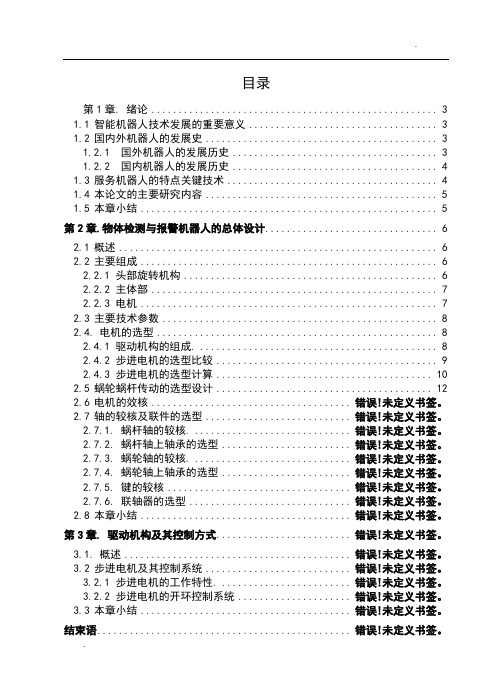
.. 目录第1章. 绪论 (3)1.1智能机器人技术发展的重要意义 (3)1.2国内外机器人的发展史 (3)1.2.1 国外机器人的发展历史 (3)1.2.2 国内机器人的发展历史 (4)1.3服务机器人的特点关键技术 (4)1.4本论文的主要研究内容 (5)1.5本章小结 (5)第2章.物体检测与报警机器人的总体设计 (6)2.1概述 (6)2.2主要组成 (6)2.2.1 头部旋转机构 (6)2.2.2 主体部 (7)2.2.3 电机 (7)2.3主要技术参数 (8)2.4.电机的选型 (8)2.4.1 驱动机构的组成. (8)2.4.2 步进电机的选型比较 (9)2.4.3 步进电机的选型计算 (10)2.5蜗轮蜗杆传动的选型设计 (12)2.6电机的效核..................................... 错误!未定义书签。
2.7轴的较核及联件的选型........................... 错误!未定义书签。
2.7.1. 蜗杆轴的较核. ............................. 错误!未定义书签。
2.7.2. 蜗杆轴上轴承的选型........................ 错误!未定义书签。
2.7.3. 蜗轮轴的较核. ............................. 错误!未定义书签。
2.7.4. 蜗轮轴上轴承的选型........................ 错误!未定义书签。
2.7.5. 键的较核.................................. 错误!未定义书签。
2.7.6. 联轴器的选型.............................. 错误!未定义书签。
2.8本章小结....................................... 错误!未定义书签。
第3章. 驱动机构及其控制方式......................... 错误!未定义书签。
机器人技术及其应用结课论文

机 器 人 技 术 及 应 用 结 课 论 文
姓名:王定 学院:仪器与电子学院 专业:微电子科学与工程 班级学号:1306034248 题目:智能引领未来 日期:2014 年 6 月 12 日
智能引领未来
摘要: 智能引领未来,机器人能力将远胜人类,这不是梦想;未来的机器人也能自
主的学习和思考,工作能力将远远超过人类,能承担大量人类所不能及的工作, 进一步推动智能科学的发展,促进社会的进步,促进经济的高速增长,而实现智 能化必须依靠强有力的硬件系统,就机器人而言,其身上集成了多种处理器、存 储器与大量的传感器,设想,当这些器件不断地走向高端化、微型化、进一步集 成化,那么机器人的处理速度将进一步提高,质量与体积将大大减小,机器人将 越来越”聪明“。
集成电路引导未来生活 一张 0.5 毫米厚的世博会门票,其“真实面目”是个集成电路产品。门票里 装了 RFID 芯片,当门票靠近读卡机时,门票上的线圈会感应出电流,电流便驱 动芯片工作,将芯片里的信号读出来。这样的门票防水、防磁,使用寿命长,且
第 2 页 共 10 页
难以伪造。 集成电路可谓无所不在、无时不有。在上海世博会各个展馆里,各种各样的
关键词: 机器人、智能、硬件系统、高端化、集成化、微型化、聪明。
引言: 现在的机器人与人类比较起来,机器人不能自主学习与自主思考,缺乏情感,
必须需要接收人的命令才能执行相关命令,或者事先就把各种命令存储到机器人 的大脑中,有需要的时候就执行命令。随着集成电路的飞速发展,处理器、存储 器、传感器等电子元件的高端化、微型化、集成化,机器人的处理速度将大大提 高,质量与体积将大大减轻,机器人会变得越来越”聪明“。
随着李德毅等人提出定性定量不确定性转换模型--云模型,并形成了云理论 等的不断创新,机器人自主学习与分析能力将有望实现,它和人一样在大脑中存 储了大量的事物,而且,他的“记忆力超强”,记忆的东西比人类更准确。
智能移动机器人机器人(两篇)
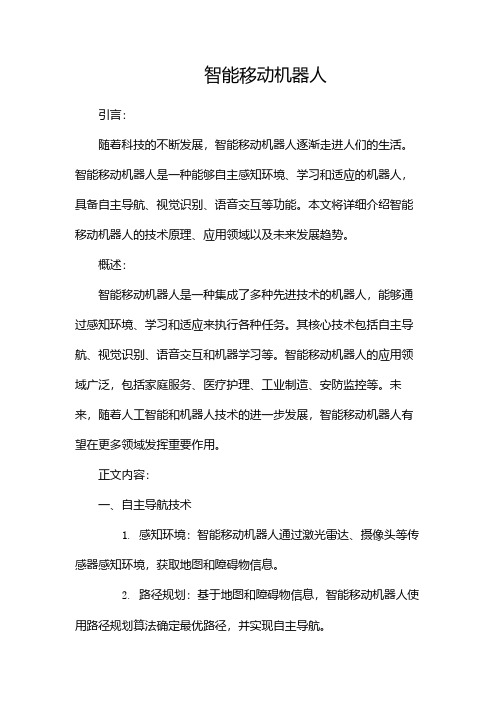
智能移动机器人引言:随着科技的不断发展,智能移动机器人逐渐走进人们的生活。
智能移动机器人是一种能够自主感知环境、学习和适应的机器人,具备自主导航、视觉识别、语音交互等功能。
本文将详细介绍智能移动机器人的技术原理、应用领域以及未来发展趋势。
概述:智能移动机器人是一种集成了多种先进技术的机器人,能够通过感知环境、学习和适应来执行各种任务。
其核心技术包括自主导航、视觉识别、语音交互和机器学习等。
智能移动机器人的应用领域广泛,包括家庭服务、医疗护理、工业制造、安防监控等。
未来,随着人工智能和机器人技术的进一步发展,智能移动机器人有望在更多领域发挥重要作用。
正文内容:一、自主导航技术1.感知环境:智能移动机器人通过激光雷达、摄像头等传感器感知环境,获取地图和障碍物信息。
2.路径规划:基于地图和障碍物信息,智能移动机器人使用路径规划算法确定最优路径,并实现自主导航。
3.避障能力:智能移动机器人能够通过感知和计算避开障碍物,确保在移动过程中的安全性和稳定性。
4.定位技术:智能移动机器人通过使用全球定位系统(GPS)、里程计、惯性导航等技术实时确定自身位置。
二、视觉识别技术1.图像处理:智能移动机器人通过图像处理技术对环境中的物体进行识别和分类。
2.物体检测:基于深度学习和计算机视觉算法,智能移动机器人能够准确地检测和识别物体。
3.人脸识别:智能移动机器人可以通过人脸识别技术识别和辨认人脸,实现人机交互。
4.姿态识别:智能移动机器人能够通过姿态识别技术获取人体或物体的运动状态,并做出相应的反应。
三、语音交互技术1.语音识别:智能移动机器人可以通过语音识别技术将语音信息转换为文本信息。
2.自然语言处理:基于自然语言处理技术,智能移动机器人能够理解和回答用户的语言命令。
3.语音合成:智能移动机器人能够通过语音合成技术将文本信息转换为语音输出。
4.语音交互界面:智能移动机器人通过语音交互界面与用户进行沟通和交流。
四、机器学习技术1.数据收集和预处理:智能移动机器人通过感知环境获取大量数据,并进行预处理和分析。
人工智能机器人论文
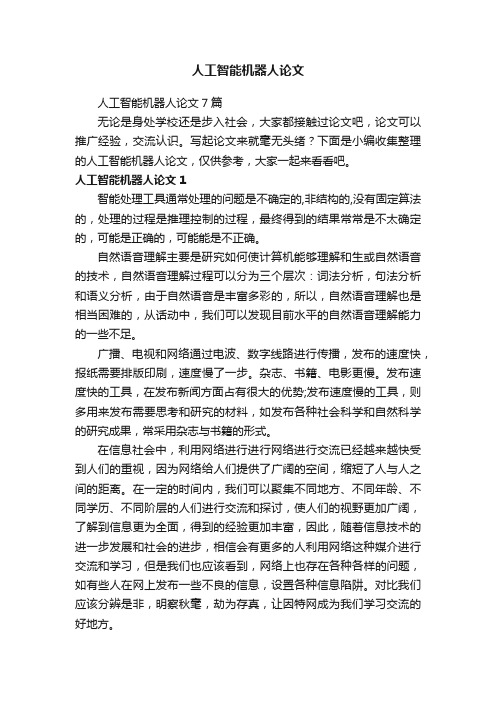
人工智能机器人论文人工智能机器人论文7篇无论是身处学校还是步入社会,大家都接触过论文吧,论文可以推广经验,交流认识。
写起论文来就毫无头绪?下面是小编收集整理的人工智能机器人论文,仅供参考,大家一起来看看吧。
人工智能机器人论文1智能处理工具通常处理的问题是不确定的,非结构的,没有固定算法的,处理的过程是推理控制的过程,最终得到的结果常常是不太确定的,可能是正确的,可能能是不正确。
自然语音理解主要是研究如何使计算机能够理解和生或自然语音的技术,自然语音理解过程可以分为三个层次:词法分析,句法分析和语义分析,由于自然语音是丰富多彩的,所以,自然语音理解也是相当困难的,从话动中,我们可以发现目前水平的自然语音理解能力的一些不足。
广播、电视和网络通过电波、数字线路进行传播,发布的速度快,报纸需要排版印刷,速度慢了一步。
杂志、书籍、电影更慢。
发布速度快的工具,在发布新闻方面占有很大的优势;发布速度慢的工具,则多用来发布需要思考和研究的材料,如发布各种社会科学和自然科学的研究成果,常采用杂志与书籍的形式。
在信息社会中,利用网络进行进行网络进行交流已经越来越快受到人们的重视,因为网络给人们提供了广阔的空间,缩短了人与人之间的距离。
在一定的时间内,我们可以聚集不同地方、不同年龄、不同学历、不同阶层的人们进行交流和探讨,使人们的视野更加广阔,了解到信息更为全面,得到的经验更加丰富,因此,随着信息技术的进一步发展和社会的进步,相信会有更多的人利用网络这种媒介进行交流和学习,但是我们也应该看到,网络上也存在各种各样的问题,如有些人在网上发布一些不良的信息,设置各种信息陷阱。
对比我们应该分辨是非,明察秋毫,劫为存真,让因特网成为我们学习交流的好地方。
智能接口技术是研究如何使人们能够方使自然地与计算机交流,为了实现这目标,要求计算机能够看懂文字、听懂语言、说话表达,甚至能够进行不同语言之间的翻译,而这些功能的实现又依赖于知识表达方法的研究,因此,智能接口技术已经取得显著成果,文字识别、语言识别、语音合成、图像机器翻译以及自然语言理解等技术已经实用化。
智能搬运机器人运动控制算法实现与路径规划实现毕业论文

智能搬运机器人运动控制算法实现与路径规划实现毕业论文目录中文摘要 (Ⅰ)英文摘要 (Ⅱ)1 绪论 (1)1.1 背景介绍 (1)1.2课题现状 (1)1.3 论文的研究思路 (2)1.4 论文的研究容 (2)2 桁架式机器人 (2)3 程序代码 (5)3.1 二轴主程序 (6)3.2 三轴主程序 (37)1.绪论1.1 背景简介传统的工业机器人常用于搬运、喷漆、焊接和装配工作。
工业现场的很多重体力劳动必将由机器代替,这一方面可以减轻工人的劳动强度,另一方面可以大大提高劳动生产率。
搬运机器人是可以进行自动化搬运作业的工业机器人。
最早的搬运机器人出现在1960年的美国,Versatran和Unimate两种机器人首次用于搬运作业。
搬运作业是指用一种设备握持工件,是指从一个加工位置移到另一个加工位置。
搬运机器人可安装不同的末端执行器以完成各种不同形状和状态的工件搬运工作,大大减轻了人类繁重的体力劳动。
目前世界上使用的搬运机器人逾10万台,被广泛应用于机床上下料、冲压机自动化生产线、自动装配流水线、码垛搬运、集装箱等的自动搬运。
部分发达国家已制定出人工搬运的最大限度,超过限度的必须由搬运机器人来完成。
搬运机器人是近代自动控制领域出现的一项高新技术,涉及到了力学,机械学,电器液压气压技术,自动控制技术,传感器技术,单片机技术和计算机技术等学科领域,已成为现代机械制造生产体系中的一项重要组成部分。
它的优点是可以通过编程完成各种预期的任务,在自身结构和性能上有了人和机器的各自优势,尤其体现出了人工智能和适应性。
应用搬运机器人进行工作,这是直接减少人力的一个侧面,同时由于应用搬运机气人可以连续的工作,这是减少人力的另一个侧面。
因此,在自动化机床的综合加工自动线上,目前几乎都有搬运机气人,以减少人力和更准确的控制生产的节拍,便于有节奏的进行工作生产。
可见,有效的应用搬运机器人,是发展机械工业的必然趋势机械手是提高劳动生产率,改善劳动条件,减轻工人劳动强度和实现工业生产自动化的一个重要手段,国外都很重视它的应用和发展。
智能移动机器人控制系统关键技术研究【控制理论与控制工程专业优秀论文】

第一章绪论松下电气公司正致力于研究在日常生活中真入如何对机器人的行为做出反应的问题,实验对象是一个为孤寡老人充当同伴的机器人。
为了使同伴机器人更友好,将它设计为一个具有肥胖动物形象的45厘米高的机器人。
它不会行走,但可以转动头和运动四肢,配备有声音识别系统的机器人可以帮助使用者与当地救护中心通讯。
娱乐机器人的种类很多,其典型代表是以机器狗“AIBO”为代表的机器宠物。
而教育机器人则是以“机器人足球”比赛为代表的各种类型的机器人。
机器狗“AIBO”是日本soNY公司在】999年推出的一款智能玩具。
它不但具有图l—lSoNY公司的AIBO图1—2SONY公司的SDR.3x可爱的造型,具有可以行走的四条腿,而且能够完成坐、趴、伸展等动作,摔倒后可以自己爬起来,其动作十分接近于真实的小狗。
此外“AIBO”还能够显示出喜、怒、哀、惊、惧、怨六种情感状态,并可以通过学习而不断“成长”。
目前国内外许多企业都在积极研制开发娱乐机器入,并推出了各种类型的娱乐机器人产品。
日本国内最大的自动化技术公司欧姆龙公司最近推出的“机器猫”产品采用了仿真皮材料和人工智能技术,在外型、叫声、以及基本行为方面都与真猫十分接近。
按移动机器人的运动方式,机器人又可分为轮式移动机器人、步行移动机器人、履带式机器人、爬行式机器人和空气推进、水下推进等。
在各种各样的机器人中,拟人机器人只占总数量的10%到15%,但拟人机器人是很多人感兴趣的一类机器人。
在对人类的感知、行为和娱乐进行科学研究时,拟人机器人作为一种科学研究平台非常有价值。
索尼公司的第二代机器人SDR一4X展示了更为复杂的行走控制和更为丰富的通讯功能。
SDR一4X的集成智能移动机器入控制系统关键技术研究实时自适应运动控制系统使它能够在不规则的地形和斜坡上行走,在外部压力下还能够保持行走姿态。
本田公司则为Asimo开发了称为i.wALK的智能实时柔性行走技术,其预测移动控制功能使机器人能够实时预测下一步运动,并按照预测来移动重心。
智能机器人论文
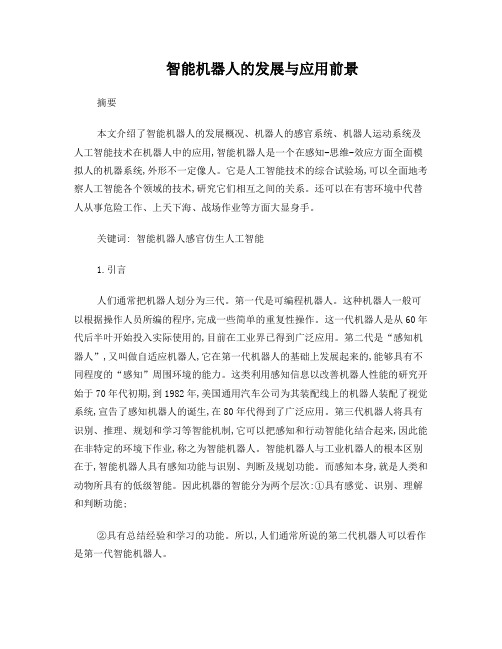
智能机器人的发展与应用前景摘要本文介绍了智能机器人的发展概况、机器人的感官系统、机器人运动系统及人工智能技术在机器人中的应用,智能机器人是一个在感知-思维-效应方面全面模拟人的机器系统,外形不一定像人。
它是人工智能技术的综合试验场,可以全面地考察人工智能各个领域的技术,研究它们相互之间的关系。
还可以在有害环境中代替人从事危险工作、上天下海、战场作业等方面大显身手。
关键词: 智能机器人感官仿生人工智能1.引言人们通常把机器人划分为三代。
第一代是可编程机器人。
这种机器人一般可以根据操作人员所编的程序,完成一些简单的重复性操作。
这一代机器人是从60年代后半叶开始投入实际使用的,目前在工业界已得到广泛应用。
第二代是“感知机器人”,又叫做自适应机器人,它在第一代机器人的基础上发展起来的,能够具有不同程度的“感知”周围环境的能力。
这类利用感知信息以改善机器人性能的研究开始于70年代初期,到1982年,美国通用汽车公司为其装配线上的机器人装配了视觉系统,宣告了感知机器人的诞生,在80年代得到了广泛应用。
第三代机器人将具有识别、推理、规划和学习等智能机制,它可以把感知和行动智能化结合起来,因此能在非特定的环境下作业,称之为智能机器人。
智能机器人与工业机器人的根本区别在于,智能机器人具有感知功能与识别、判断及规划功能。
而感知本身,就是人类和动物所具有的低级智能。
因此机器的智能分为两个层次:①具有感觉、识别、理解和判断功能;②具有总结经验和学习的功能。
所以,人们通常所说的第二代机器人可以看作是第一代智能机器人。
2.智能机器人的感官系统2.1触觉传感器英国近几年在阵列触觉传感方面开展了相当广泛的研究。
例如:Sussex大学和Shack-leton系统驱动公司研制的基于运动的介电电容传感的阵列;由威尔士大学和软件科学公司研制的采用压强技术的装在机器人夹持器上的传感器。
2.2视觉传感在机器人视觉方面,目前市场上销售的有以下6类传感器:①隔开物体的二维视觉:双态成像;②隔开物体的二维视觉:灰度标成像;③触觉或叠加物体的二维视觉;④二维观察;⑤二维线跟踪;⑥使用透视、立体、结构图示或范围找寻技术从隔开物体中提取三维信息。
- 1、下载文档前请自行甄别文档内容的完整性,平台不提供额外的编辑、内容补充、找答案等附加服务。
- 2、"仅部分预览"的文档,不可在线预览部分如存在完整性等问题,可反馈申请退款(可完整预览的文档不适用该条件!)。
- 3、如文档侵犯您的权益,请联系客服反馈,我们会尽快为您处理(人工客服工作时间:9:00-18:30)。
华中科技大学研究生课程考试答题本考生姓名考生学号系、年级类别考试科目智能移动机器人考试日期 2014年12月26日评分注意:1、无评卷人签名试卷无效2、必须用钢笔或者圆珠笔阅卷,使用红色。
用铅笔阅卷无效(双面打印)Control Architectures for IntelligentMobile RobotsAbstract. Control architecture is a very important concept for the designof intelligent mobile robots. This article has a simple introduction aboutthe dominant control architectures, i.e. deliberative control architecture,reactive control architecture hybrid deliberative/reactive controlarchitecture and behavior-based control architecture. Meanwhile,introduce the subsumption control architecture which is similar to thebehavior-based control architecture, but very popular. In the time, thearticle makes comparisons between them, and introduces theiradvantages and disadvantages.Keywords. Mobile robots, Robot control, Control architecture1 IntroductionIn the 21st century, it is expected that robots with different degrees of autonomy and mobility will play an increasingly important role in all aspects of human life. With the robotic technologies development of the robotics with the past few years, there are more and more inspiring and remarkable success stories for robotics. And mobile robots have been widely applied in many fields. Such as factory automation dangerous environment detection, office automation, hospital, entertainment, education, space exploration, farm automation, military and security system.Furthermore, mobile robots pose a unique challenge to artificial intelligence researchers. Mobile robots need to be used to deal with key issues such as uncertainty, reliability, and real-time response.For dealing with the challenge, control architecture for mobile robots becomes a growing interest and a popular subject. Robotic control architecture can be seen as a mixture of engineering and cognitive science and as such it presents unusual challenges to the programmer. Robotic control methodologies have tended to move from simplistic, predefined actuator actions based on specific input criteria to tightfeedback loops with input from the environment, giving more robust solutions. In these environments, where many such control loops are required, the opportunities for the application of parallel programming to create simple and robust solutions are numerous.Even simple robots can have many different tasks to do simultaneously. For example, a robot might try to avoid bumping into walls whilst also trying to create the largest treacle pudding in the world. The latter task is the main purpose of the robot, but the first is important for the robot to meet its goal as designed and needs to be handled constantly alongside the robot’s main task.So an excellent control architecture for mobile robots is a very important. The article has a simple introduction to the control architecture.2 The control architecture for intelligent mobile robotsIn the charter, we will have a quick look at some main control architectures which are deliberative control reactive control hybrid control and behavior-based control and introduce how they work. The Table 1 shows the difference between them.Table 1: Difference between control architectures2.1 The Deliberative Control ArchitectureThe deliberative control architecture, namely hierarchical control architecture, uses a centralized world model for verifying sensory information and generatingactions in the world. More simply, the robot takes all of the available sensory information, and all of the internally stored knowledge it has, and it reasons about it in order to create a plan of action. When it faces with the relative situation, the robot senses its environment, plans its next action based on these senses, and then takes appropriate action using available actuators.From what said above, it’s easy to find that th e robot explicitly plans its next action from the knowledge it has gathered about the environment so far at every stage. Essentially these robots just select actions from rule matches on the current ‘perceptions’ from sensory input. The follow Figure 1 shows the structure of a deliberative robot control architecture. From the figure, it’s easy to know that the work method is that the modules that be designed in advance work to read values from the sensors available to provide data about the environment, devise strategies to perform the desired behaviors given the environmental state, and then compose the signals that control the actuators to achieve those behaviors.Figure 1: The typical structure of a deliberative robot control system But in the early stage, the approach employs a top-down analysis of the desired behavior of the robot during the design phase and then the implementation of a sequence of modules. So deliberative approaches have been criticized for scaling poorly with the complexity of the problem and consequently not allowing for reaction in real-time.2.2 The Reactive Control ArchitectureStrictly speaking, the reactive control architecture is not a control architecture, for the purely reactive systems do not use any internal representation of the environment, and perform no search: they react to the current sensory information.The typical structure of a reactive robot control system (as shown in Figure 2) is very simple.Figure 2: The typical structure of a reactive robot control system Comparing with the deliberative control architecture, it can be found that reactive systems have no the ‘Plan’ unit. Actually they use a direct mapping between sensors and actuators, and minimal, if any, state information. They consist of collection of rules that map specific situations to specific actions. Just like the knee-jerk reaction, they are based on “stimulus-response”. And it won’t be decided by your brain. So we can say the way that reactive control works is similar with the unconditioned reflex of the human. It’s a great idea, because you should do all the things by your brain, or you will be very tired. It’s the same for robots. And this allows the robot to respond very quickly to changing and unstructured environments at the same time.Every coin has two sides. It can’t be exception. The reactive control architecture also has many disadvantages. For example, it is often too difficult to split up all possible situations this way, or it may require unnecessary encoding. Limitations to this approach are that such robots, because they only look up actions for any sensory input, do not usually keep much information around, have no memory, no internalrepresentation around them, and no ability to learn over time. Due to their inability to store information dynamically, purely reactive strategies are less used, although it’s effective for a variety of problems.All in all, with more and more building blocks of a reactive system (reactive rules coupling sensors and actuators) developed, it has a bright future.2.3 The Hybrid Deliberative/Reactive control architectureThe two kinds of control architectures mentioned above both have advantages and disadvantages. So designers came up with the hybrid deliberative/reactive control architecture to combine the best of both Reactive and Deliberative approaches. Just like the human, we control our bodies by spinal cords and brains. The deliberative approach like the control by the brain, and the reactive approach like the control by spinal cords. So in the hybrid deliberative/reactive control architecture, one part of the robot’s “brain” plans, while another deals with immediate reaction, such as avoiding obstacles and staying on the road. If we just put the two parts together, it’s can’t get the result that one add one greater two. The greater challenge of this approach is not just bringing the two parts of the brain together, but also allowing them to talk to each other, and resolve conflicts between the two. So a “third” part of the robot brain is required. A s a result these systems are often called “three-layer systems”.The three-layer architecture consists of three components: a reactive feedback control mechanism, a reactive plan execution mechanism, and a mechanism for performing time-consuming deliberative computations.In different robots, the components have different names. So we just named them with the controller, the sequencer, and the deliberator.The controller consists of one or more threads of computation that implement one or more feedback control loops, tightly coupling sensors to actuators. Usually the controller contains a library of hand-crafted transfer functions. Which ones are active at any given time is determined by an external input to the controller.The sequencer's job is to select which primitive Behavior (i.e. which transfer function) the controller should use at a given time, and to supply parameters for the Behavior. By changing primitive Behaviors at strategic moments the robot can be coaxed into performing useful tasks. Of course, that the outcome of selecting a particular primitive in a particular situation might not be the intended one. So the sequencer must be able to respond conditionally to the current situation, whatever it might be.The deliberator is the locus of time-consuming computations. The deliberator can interface to the rest of the system in two different ways. It can produce plans for the sequencer to execute, or it can respond to specific queries from the sequencer. The deliberator is very smart but slow. It likes your brain.Now let’s look at the structure of the hybrid deliberative/reactive control architecture (as shown in Figure 3).Figure 3: The typical structure of a hybrid robot control system From the figure 3, we can get that the sense-plan-act (SPA) approach has a significant architectural feature. It’s that the flow of control among these components is unidirectional and linear. Information flows from sensors to world model to plan to effectors, never in the reverse direction.The hybrid deliberative/reactive control architecture is very popular. There areseveral systems which demonstrate the hybrid deliberative/reactive control approach: Arkin’s AuRA [Arkin, 1986], Gat’s Atlantis [Gat 1991], Lyon’s Planner-Reactor [Lyons & Hendriks, 1992], Georgeff’s PRS [Georgeff & Lansky 1987], etc.2.4 The Behavior-Based Control ArchitectureThis chapter will introduce the behavior-based control architecture which is one of the three dominant paradigms for robot control. The other two are reactive control and hybrid control.The behavior-based control is focused around the idea of removing centralized control structures and instead linking actions directly to changes in the input sources themselves. The behavior-based approaches are an extension of reactive systems that fall between the purely reactive and the planner-based extremes. The behavior-based strategies are strictly more powerful than purely reactive approaches since they have no fundamental limitations on internal state.A behavior-based control system has a general structure that is similar to that shown in Figure 4. It is composed by various interconnected agents forming a control system in a layered fashion. The interconnections between agents are dynamically established, and are controlled by a message passing system.As can be seen in Figure 4, there are three categories of agents. The agents in charge of acquiring information about the environment are the Sensor agents and are directly or indirectly connected to physical sensors. Those indirectly connected to physical sensors, like Agent S3 in Figure 4, just process information delivered by other agents, and are called Virtual Sensor agents. In a similar way, there are Actuator agents, which send information to physical actuators present in the system. There are also Virtual Actuator agents, which are similar to the virtual sensor agents.Finally, there is a last group of agents, called Behavior agents, which receive information from the Sensor agents, process it, and send the results to the Actuator agents or other Behavior agents. As any other agent, the Behavior agents can be activeor inactive in a given instant. In Figure 4, the agent B2 is inactive. Immediately after being activated by a message sent by agent B1, it must rearrange the connections in order to modify the overall behavior of the system.Figure 4: A behavior-based control system considered as an interconnection of agentsThe key difference between behavior-based and hybrid systems is in the way representation and time-scale are handled. Hybrid systems typically employ a low-level reactive system that functions on a short time-scale, and a high-level planner that functions on a long time-scale. The two interact through a middle layer. Consequently hybrid systems are often implemented with so-called three-layer architectures.In contrast, behavior-based systems attempt to make the representation, and thus the time-scale, of the system uniform. Behavior-based representations are parallel, distributed, and active, in order to accommodate the real-time demands of other parts of the system. Furthermore, they are implemented using the behavior structure, much like the rest of the system.2.5 The Subsumption Control ArchitectureThe subsumption control architecture is probably the most widely known mobile robot control architecture. Subsumption has been widely influential in autonomous robotics and elsewhere in real-time AI. It was introduced by Rodney Brooks and colleagues in 1986.The subsumption control architecture is a reactive robotic architecture heavily associated with behavior-based robotics.Now, let’s have a look at the difference between the traditional architectures (as shown in Figure 5) and the Brook’s subsumption archi tecture (as shown in Figure 6).Figure 5: Traditional Architectures (Linear Organization)Figure 6: Brook’s Subsumption Architecture (Parallel Organization) The subsumption approach involves building robot control systems with increasing levels of competence. Each additional level builds upon and potentially interacts with the inputs and outputs of existing, previous levels to add higher levels of competency, leaving the lower levels intact, functional and operational within the overall system. The higher levels build upon the lower levels to create more complex behaviors. The behavior of the system as a whole is the result of many interacting simple behaviors. The layers operate asynchronously. Thus, each layer is fully capable of controlling the robot by itself, albeit in a possibly simple-minded way.The main advantages of the architecture are:1) The emphasis on iterative development & testing of real-time systems in their target domain;2) The emphasis on connecting limited, task-specific perception directly to the expressed actions that require it;3) The emphasis on distributive and parallel control, thereby integrating the perception, control, and action systems in a manner similar to animals.The main disadvantages of the architecture are:1) The difficulty of designing adaptable action selection through highlydistributed system of inhibition and suppression;2) The lack of large memory and symbolic representation, which seems to restrict the architecture from understanding language;When subsumption architecture was developed, the novel setup and approach of subsumption architecture allowed it to be successful in many important domains where traditional AI had failed, namely real-time interaction with a dynamic environment. The lack of large memory storage, symbolic representations, and central control, however, places it at a disadvantage at learning complex actions, in-depth mapping, and understanding language.3 ConclusionsThis article described the main control architectures for intelligent mobile robots. It has been seen that the control architecture constrains the way an autonomous robot senses, reasons and acts, thus affecting its task performance. So having a good knowledge of control architectures is essential for the designers to design a mobile robot. At the same the article makes comparisons between them in order to understand them better.AcknowledgementsAt the end of the article, I am very grateful to my teacher Professor Luo for his careful classroom instruction. Meanwhile thanks to the pioneers of the robotics for their great contribution to the world.References[1] Karrera Amaierako Proiektua. Agent-based control architecture for a mobile robot.[2] Jonathan SIMPSON, Christian L. JACOBSEN. Mobile Robot Control The SubsumptionArchitecture and occam-pi. Communicating Process Architectures. 2006[3] Erann Gat. On Three-Layer Architectures . Artificial Intelligence and Mobile Robots. AAAIPress.[4] Arkin, R.C. Behavior-Based Robotics. Cambridge. MA: MIT press. 1998[5] Brooks, R.A. A robust layered control system for a mobile robot. IEEE Journal of Roboticsand Automation, RA-2. 1986[6] Daniel Toal, Colin Flanagan. Subsumpption architecture for the control of robots.[7] Magnus Egerstedt. Control of Autonomous Mobile Robots .[8] Omead Amidi. Integrated Mobile Robot Control . Carnegie Mellon University . 1990[9] Kirsanov Kirill . The Architecture of Robotics Control Software for HeterogeneousMobile Robots Network. 24th DAAAM International Symposium on IntelligentManufacturing and Automation, 2013[10] Jonathan H. Connell. SSS: A Hybrid Architecture Applied to Robot Navigation. theProceedings of the 1992 IEEE Conference on Robotics and Automation (ICRA-92), pp.2719-2724.[11] José Eduardo Mendonça Xavier, Hansjörg Andreas Schneebeli. A Framework based onconcurrent Object-oriented programming for Building Behavior-based Control Systems for Mobile Robots.[12] Subsumption architecture. /wiki/Subsumption_architecture[13] Behavior-based robotics. /wiki/Behavior-based_robotics[14] Hierarchical control system. /wiki/Hierarchical_control_system[15] Robotic paradigms. /wiki/Robotic_paradigms。
